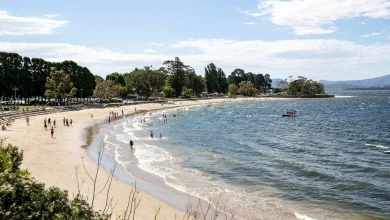World’s largest aircraft carrier in position as Trump weighs Venezuela strike

Admiral Alvin Holsey, the commander who oversees the Caribbean and Latin America, said in a statement that the American forces “stand ready to combat the transnational threats that seek to destabilise our region”.
Holsey, who will retire next month after just a year on the job, said the strike group’s deployment was “a critical step in reinforcing our resolve to protect the security of the Western Hemisphere and the safety of the American Homeland.”
‘I think everyone is watching this with sort of bated breath to see just how willing the US is to really use military force.’
Elizabeth Dickinson, International Crisis Group senior analyst
In Trinidad and Tobago, which is only 11 kilometres from Venezuela at its closest point, government officials said troops have begun training exercises with the US military that will run through much of the week.
Minister of Foreign Affairs Sean Sobers described the joint exercises as the second in less than a month and said they were aimed at tackling violent crime on the island nation, which has become a stopover point for drug shipments headed to Europe and North America. The Trinidad and Tobago’ prime minister has been a vocal supporter of the US military strikes.
The exercises will include Marines from the 22nd Expeditionary Unit who have been stationed aboard the navy ships that have been looming off Venezuela’s coast for months.
Venezuela’s government has described the training exercises as an act of aggression. It had no immediate comment on the arrival of the aircraft carrier.
The administration has insisted that the build-up is focused on stopping the flow of drugs into the US, but it has released no evidence to support its assertions that those killed in the boats were “narco-terrorists”. Trump has indicated military action would expand beyond strikes by sea, saying the US would “stop the drugs coming in by land”.
The US has long used aircraft carriers to pressure and deter aggression by other nations because its warplanes can strike targets deep inside another country. Some experts say the Ford is ill-suited to fighting cartels, but it could be an effective instrument of intimidation for Maduro in a push to get him to step down.
Pressure on Maduro
US Secretary of State Marco Rubio says his country does not recognise Maduro, who was widely accused of stealing last year’s election, as Venezuela’s legitimate leader. Rubio has called Venezuela’s government a “trans-shipment organisation” that openly co-operates with those trafficking drugs.
Maduro, who faces charges of narco-terrorism in the US, has accused Washington of “fabricating” a war against him. Venezuela’s government recently touted a “massive” mobilisation of troops and civilians to defend against possible American strikes.
Trump has justified the attacks on drug boats by saying the US is in “armed conflict” with drug cartels while claiming the boats are operated by foreign terror organisations.
He has faced pushback from leaders in the region, the UN human rights chief and US lawmakers, including Republicans, who have pressed for more information on who is being targeted and the legal justification for the boat strikes.
Loading
Senate Republicans, however, recently voted to reject legislation that would have put a check on Trump’s ability to launch an attack against Venezuela without congressional authorisation.
Experts disagree on whether American warplanes may be used to strike land targets inside Venezuela. Either way, the 90,000-tonne warship is sending a message.
“This is the anchor of what it means to have US military power once again in Latin America,” said Elizabeth Dickinson, the International Crisis Group’s senior analyst for the Andes region. “And it has raised a lot of anxieties in Venezuela, but also throughout the region. I think everyone is watching this with sort of bated breath to see just how willing the US is to really use military force.”





